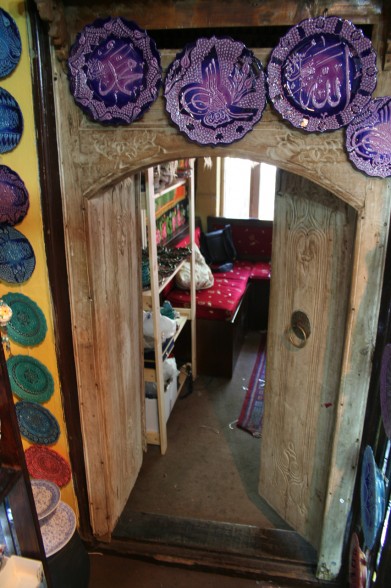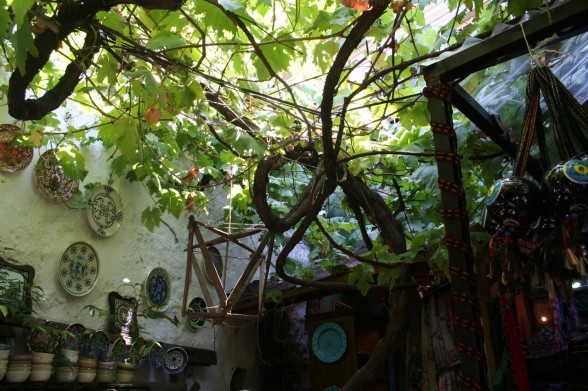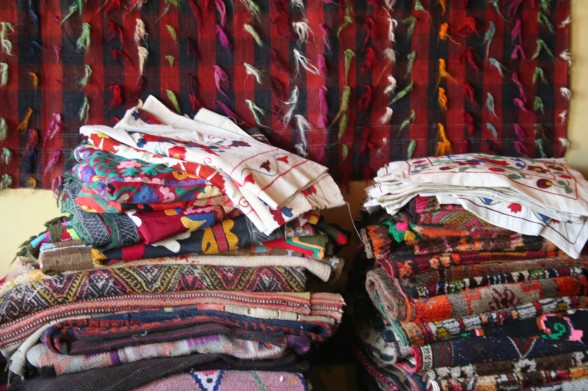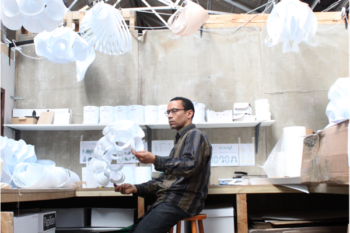Taner Sağıroğlu sits in the office of the wooden, historic Ottoman building which houses his carpet shop. Outside there’s a tranquil, vine-covered courtyard decorated with painted tiles from nearby Iznik, but winter arrived early this year and in mid-October it’s already too cold for sitting outside. The floor of the room has a warped hump rolling across it; one wall is covered in wood panelling, doors concealing handy-looking cupboards in the wall.

Taner set up shop here in 1985, after ten years living in Italy, during which time he acquired a fluent Italian with a slight Neapolitan accent.
“This isn’t a big business”, says Taner. “I don’t deal through middlemen or wholesalers. That’s a great advantage because it means I know where each carpet comes from – I buy it off the original owner.”
Over the years, Taner’s shop has become well known in carpet making communities and these days people often come to find him when they have carpets to sell.
“A few months ago, a guy from Uzbekistan showed up in my shop.” Taner reminisces. “I’d never seen him before, but he had come to find me because he knew I would buy what he had to sell. He’d travelled by bus from Uzbekistan to Turkey with a suitcase full of handmade crafts: carpets, hand-embroidered hats, hanging decorations made from flattened goat hair.”

Other carpets come from Eastern Turkey, Afghanistan, Turkmenistan. Each piece is unique, because they are all woven by hand.
“the way to tell a machine woven carpet from a hand-made one is to hang two of them side by side. If the patterns are exactly the same it means they were made by machine.”
Carpet weaving is like cooking, it turns out. You and I can follow the exact same recipe, but the food will end up tasting different because we each have our own style: your pinch of salt is a shade bigger than mine, you beat the eggs a little more firmly than I do. Likewise, two carpet weavers can work from the same pattern, but since each carpet is the work of an individual, it’s impossible to find two exactly the same.

In Turkey, traditionally only the women make carpets, whereas in countries like Afghanistan and Turkmenistan it’s a men’s job. Teenage girls usually weave a couple of carpets as part of their dowry.
Why do people sell? A variety of reasons. Sometimes they need money, sometimes they want to ‘upgrade’ to a more modern (machine woven) design.
In times gone by, Bursa was the end point of one of the Silk Road branches, receiving silk, spices and other goods from Central Asia. These days, the shops surrounding the 16th Century koza han (silk hall) in the historic centre still sell all kinds of fine silk products, even if they are no longer woven in the city’s houses like once upon a time.
Recently he’s started selling hand-painted ceramics too. He promises me that next time we’ll go to see the ceramic workshop.
Nowadays the goods arrive by bus rather than camel train, but Bursa is still the last stop on a silk road of sorts.
Taner is one of the sellers we work with in our PocketButiks online boutiques project. Browse the handmade carpets at Anadolu Kilim’s online boutique.
Photo credits: Marcello Boschetti




